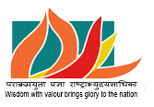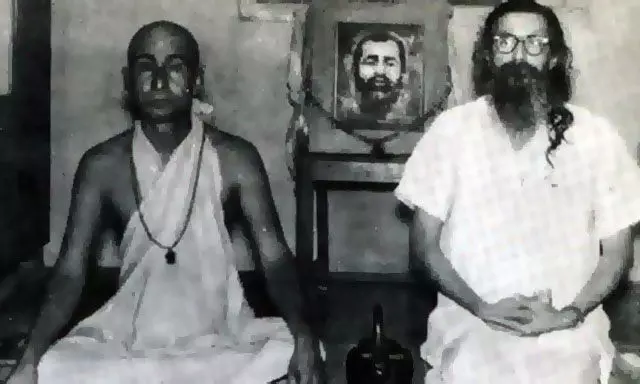MS Golwalkar, deeply influenced by the Ramakrishna-Vivekananda tradition, epitomised both spirituality and nationalism—dedicating his life to India’s civilisational resurgence and nation-building with unwavering fearlessness and selfless commitment
To anyone who reads Sri Guruji’s talks and addresses on Sri Ramakrishna and Swami Vivekananda it becomes evident that he spoke from a deep and direct knowledge of the Ramakrishna movement and of its essential philosophical and spiritual foundations. For Sri Guruji, this was obviously not a mental construct or a superficial absorption. It had evolved and had emerged from a process of direct initiation and immersion he had undergone at Sargachi.
HV Seshadri, in a brief analysis of Sri Guruji’s life, writes that ‘apart from having an extraordinary ability to mobilize people and mould their lives and his organizational ability’, Sri Guruji’s ‘extraordinary mental acumen enabled him to merge his personality entirely in the national life.’ To Seshadri, Sri Guruji had succeeded ‘brilliantly in fulfilling’ Vivekananda’s dream of seeing workers for India’s rise emerge in waves. ‘The greatest gift of Sri Guruji,’ writes Seshadri, ‘was the casting of brilliant young men committed to serving this nation in the mould of Swami Vivekananda’s firebrand life.’
When prodded once on why he had first gone over to the atmosphere of Sri Ramakrishna Ashram from the Sangh and then returned to the Sangh work, ‘leaving the Ashram’ and had he not seen that the ‘atmosphere of the Sangh’ was different from that of an Ashram.’ Golwalkar, who was usually reticent to speak on this personal dimension of his life, replied that it was Dr Hedgewar, better than him, who ‘could speak with authority [on] whether there is any difference between the atmosphere of the Sangh and that of an Ashram…’ Making one of those rare remarks about oneself, Sri Guruji observed that there was no dichotomy, no separation, no divorce or segregation between the ideals of the Sangh and its work and that of the message and mission of Swami Vivekananda.
‘Right from the beginning,’ Golwalkar told his insistent interlocutor, ‘My involvement in the national integration work has been as much as it is in spiritual pursuit. From my experiences during my stay in Benares, Nagpur and Calcutta, I have realised that I could do the work better through the Sangh. Therefore, I have dedicated myself to the Sangh work. I believe that this act of mine agrees with the ideals, message and mission of Swami Vivekananda. No other great man or philosophy could ever exert greater influence on me than him and his message. I have firm conviction that I could go ahead with this work remaining in the Sangh.’
Late P Parameshwaran, a leading stalwart thinker and thought-leader produced by the RSS movement, best describes these dominant and driving dimensions of Sri Guruji’s personality. Parameswaran, who first met Golwalkar, when not yet twenty, argues that Golwalkar’s mighty personality had combined in itself ‘two great streams of our ancient national life – the spiritual and the national.’ They were present in his life from the beginning, argues Parameshwaran, mingling later into a mighty flow. Sri Guruji had ‘inherited the timeless spiritual tradition of Sanatan Dharma from Sri Ramakrishna Paramahamsa, Swami Vivekananda and Swami Akhandananda Maharaj who was his deeksha guru. From Lokmanya Tilak, Veer Savarkar and Dr Hedgewar, he had inherited the nationalistic stream, which became an inseparable part of his very constitution. Though at times, the spiritual dimension gained dominance over the other.’ Sri Guruji, Parameshwaran observes, ‘could never break away from the nationalist moorings. At first it was an uneasy coexistence which later evolved into one harmonious, single, sacred flow as in the case of Swami Vivekananda and Sri Aurobindo. The spiritual and the national so intermingled that they became identical and inseparable.’ For Golwalkar, thus, ‘worship of the motherland became worship of the divine mother.’
In and around 1963, Swami Vivekananda’s centenary year, Sri Guruji addressed gatherings, public meetings and programmes across India, speaking on Vivekananda’s life and message. He had begun his spiritual seeking in the centenary year of Sri Ramakrishna as a young novice-seeker, and now in the centenary year of Vivekananda, he spoke as a towering figure of post-independent India.
Sri Guruji’s stress was on Vivekananda’s message which spoke of the need for worldly action that would lead to India’s reinstatement as a global power and teacher radiating knowledge. He spoke of Vivekananda’s message for national regeneration, he spoke of Vivekananda’s emphasis and insistence on the need to preserve Dharma as the foundation and upholding pillar of civilisational India. He spoke of Vivekananda’s exhortation for the recovery of our knowledge and our dharmic bases, of the need to reject imitations of systems and frameworks that were not essentially ours, of the need to empower those who have been discriminated against and have been hitherto seen with an ‘ill-look’. In line with Vivekananda’s vision, Sri Guruji argued that economics and politics weren’t the sole criteria for national regeneration and recovery, and that a collective consciousness of a united spiritual sense and essence was imperative for national resurgence. These and many more facets Sri Guruji dwelt on.
One of his finest expositions of Vivekananda’s message which needed to permeate our quest for national awakening was his talk on ‘Jagadguru Vivekananda’, delivered in Chennai on February 3, 1963, heralding Vivekananda’s birth centenary celebrations. The Sargachi quest, as it were, had come a full circle.
For Golwalkar, the Sangh’s mission and work represented the practical Vedanta of Vivekananda. Those who have worked to forcefully secularise Vivekananda find this dimension disturbing, unable to straitjacket it through their imposed narrative. That he was a direct initiate of the Ramakrishna order is a dimension of Sri Guruji’s personality and life that is often marginalized or minimized by his critics. Swami Niramayananda’s reminiscences of life in Sargachi under the spiritual tutelage of Swami Akhandananda, is an authentic description of those years. Niramayananda, known as Bibhuti among his spiritual comrades, was Golwalkar’s spiritual-camp mate at Sargachi serving Akhandananda. The link thus was more than direct, it was a live and sparking one. Sri Guruji’s critics mostly base themselves on half-information and motivated interpretation led by preconceived biases formed and shaped by certain ideologies. These ideologies themselves have never stuck roots in the Indian ideational ethos and have instead always articulated deconstructionism and conflict.
Establishing Golwalkar’s fundamental and formational link to the Ramakrishna order comes across as problematic for those who wish to delink him from that essence and ethos of India which Sri Ramakrishna and Vivekananda propounded and symbolised. The more they realise that divorcing Golwalkar from the essence of the Ramakrishna-Vivekananda world-view and thought is impossible the more they have tried to present Golwalkar as a diabolic schemer out to twist and to make profane the essence of India as articulated by these epoch-shaping Masters. The centenary year of RSS is now seeing an entire industry of calumny, supported by some of the leading international publishing houses, churning out research-potboilers on Golwalkar and RSS.
In the true tradition of his Guru, Golwalkar never reacted to personal calumny or to criticism, choosing instead to speak out for India and for her civilisational rise. Indefatigably he spoke against those forces, ideas, conglomerates and ideologies which he saw, as trying to systematically stymie that rise and to deracinate India from her civilisational, cultural and spiritual roots. In this he was, like his Gurus Akhandananda and Vivekananda, unsparing and scathing.
In doing this, Golwalkar, to the chagrin of his detractors during his lifetime and to his critics now, was fearless. Vivekananda’s fearlessness drove Golwalkar, after-all he had imbibed it through a direct spiritual lineage. ‘Swamiji exhorted us,’ he once said in a public address, ‘to be fearless. Should we worship God only in His sweet form…Swami Vivekananda says – “Worship the terrible form of Rudra, stand up fearlessly…Swamiji was very strong and fearless. We believe in the philosophy that death is not fearsome. Swamiji has said, “Anandam brahmano vidvan na bibheti kutascana” – the wise who revels in the bliss of Brahman fears none (Taittiriya Upanishad). Why should we fear anything? We should have fearlessness ingrained in our minds.’
Golwalkar radiated an unalloyed fearlessness throughout his life. That comes across as problematic for those who wish to reduce him to a pedantic, cliched, commonplace thinker and provocateur. He remains the principal targets of ideologues and political ideologies inimical to the Sangh and with no understanding of India’s civilisational essence.
S Gurumurthy, public intellectual associated with the Sangh for over five decades, perhaps best describes the Ramakrishna-Vivekananda link and the RSS. In a paper on ‘Shri Guruji: a saint who renounced his sainthood to re-build a mighty India’, Gurumurthy argues that ‘It is undeniable that the ideology of the RSS is clearly and explicitly traceable to the gigantic nationalist ideas and thoughts that emanated from Swami Vivekananda. But apart from this ideological inspiration, that there was a live and direct spiritual link between the Ramakrishna-Vivekananda spiritual nationalist penance and the evolution of the RSS, is least noticed in Indian intellectual discourses. The bridge that constituted this direct spiritual link between Sri Ramakrishna-Vivekananda tradition and the RSS was Shri Guruji Golwalkar, the second Sarsanghchalak of the RSS who shaped the intellectual and spiritual foundations of the RSS. But this subtle, least known, link between the kinetic RSS and the spiritually potent Sri Ramakrishna Order is not within comprehension of rational India which does not recognise mystic aspects of existence.’
Gurumurthy’s argument reinforces the fact of Golwalkar’s direct link with the Ramakrishna-Vivekananda order and of his taking up Sangh’s work for national regeneration as enunciated by both Sri Ramakrishna and Vivekananda. ‘Guruji subsumed his high personal spiritual stature,’ observes Gurumurthy, ‘and abandoned his penance for personal spiritual advancement, which would have led him to sainthood,’ and undertook on a mission mode, the ‘more and perhaps most arduous dimension of Swami Vivekananda’s agenda, namely, man-making and nation-building through the RSS.’
This decision might have denied Shri Guruji his ‘rightful place among the great saints of India. Renunciates give up normal life, name and fame, but they are eternally elevated to rank among the revered saints.’ Golwalkar on the other hand, argues Gurumurthy, ‘consciously and gladly renounced sainthood and turned a social scavenger to rid the Hindu society of the evils which it had accumulated over centuries…’ Golwalkar followed, in letter and spirit, his Guru’s injunction that he must not linger on in the Himalayas in solitude. Such a wandering was not for him,
Those who fail to see the Ramakrishna-Vivekananda dimension, or refuse to understand or acknowledge its upholding essence in Golwalkar’s life, have in reality failed to understand Sri Ramakrishna, Vivekananda and their initiate Golwalkar. They failed to discern the aspirations and hopes of the rise of a civilisational India. The seeds that were scattered and sown in the spiritual fields of Sargachi by Sri Ramakrishna’s spiritual tiller Akhandananda, eventually reaped into a self-renewing national harvest, perennially replenishing India’s quest for self-recovery and self-expression. That truth cannot be ignored or obfuscated.
Source:
https://www.millenniumpost.in/opinion/the-direct-live-spiritual-link-589958
(The views expressed are the author's own and do not necessarily reflect the position of the organisation)


